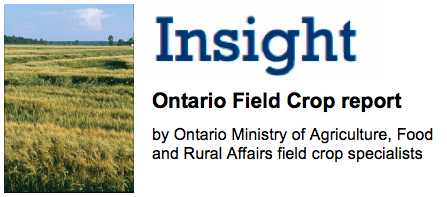by GREG STEWART
Summary:
The 2012 corn year had high expectations, high tension and in the end quite high yields. Corn planting was completed in near record time. On June 1, we had near record acreage and arguably the best looking corn crop ever. Dry weather in June and July significantly stressed the crop but August rainfall made for a reasonable grain filling period. By the end of the season the Ontario Crop Heat Unit (CHU) accumulation was above the 30 year normal for most locations in the province. For example, the CHU accumulation (May 1 to season-end) at London was 5% above normal, Mount Forest was 4% above normal and Ottawa was 6% above the 30 year normal.
Corn yields were surprisingly good; with about 77 % of the yields submitted to Agricorp, the provincial average yield stands at 158 bu/ac (9.9 tonnes/ha); when all calculations are completed the provincial corn yield for 2012 will most likely settle at or very near the past five year average of 149.6 bu/acre.
The 2012 harvested grain corn acreage will be approximately 2.2 million acres (890,700 ha) up significantly from last year. The relatively open fall coupled with high CHUs and good harvest conditions meant that virtually all the crop was harvested before December 15.
Growing Season:
April weather was abnormally dry and planting conditions were excellent across most of the province such that by May 5 corn planting was virtually complete. May rainfall was near normal in most areas of the province. Areas to the south and west of London received good rainfall distribution through most of June and July. However the rest of the province was quite dry through this period. Certain areas (i.e. Niagara, Waterloo, and Renfrew) were particularly hard hit by the dry weather. However, for the vast majority of corn acres August rains came in time to preserve kernel number and decent growing conditions throughout August and September lead to good yields in many areas and record breaking yields in the south west portions of the province. All corn matured (black layer formation) before killing frosts. Some corn that filled quite slowly because of dry soil conditions did not dry down normally. A relatively wet October which left some grain no drier in late October that it was by the end of September. Favourable November conditions allowed the crop to dry down and for the most part test weight and drying concerns were minimal.
Insights:
Good soil conditions early in the season and low precipitation generally allowed for excellent early root growth and help set the crop up to withstand a dry July.
Early season weather conditions tended to increase mineralization of organic matter and result higher residual nitrogen in the soil. The OMAFRA Pre-Sidedress Nitrate Test (PSNT) Survey done in late May indicated soil nitrate levels that were above average. Research plots and producer fields tended to indicate N fertilizer requirements in 2012 were below average even in the face of high yields. Leaf and stalk diseases were generally quite low in 2012 and ear mould presence and the resulting vomitoxin in the grain supply was below average as well.
2013 Outlook:
Optimism is high for corn in 2013 due to the high productivity of the corn crop in the past several years. This is tempered somewhat by increasing input prices including fertilizer, seed, and land rents. Some new interest may be expressed over the use of pesticides as an insurance plan even in the absence of any identifiable pest, i.e. fungicide application on corn, seed treatments and genetic protection from root worm on rotated ground.



